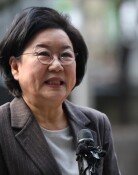Short-term Foreign Debt Shoots Up
Short-term Foreign Debt Shoots Up
Posted November. 10, 2007 07:50,
It is hard to find anything reminiscent of what happened during the Asian financial crisis. Less than three years after receiving bail-out funds from the International Monetary Fund (IMF) in August 2001, Korea got itself out of the IMF management system. Unlike a decade ago, when foreign exchange reserves almost hit bottom to defend Koreas exchange rate, Koreas foreign reserves now rank fifth in the world. The nations stock market is booming at around 2,000. Still, there are uncertainties regarding the Korean economy.
Koreas economic growth engine, in particular, has lost steam, reducing the nations growth rate to lower than that of other countries in Asia and the world. Unemployment rates are going up, and the public sector is disconcerting. Soaring oil prices that are close to $100 a barrel, a declining won-dollar exchange rate stemming from a collapse in value of the dollar, U.S. sub-prime mortgage crisis and a nose-dive in semiconductor prices are some of the malicious elements plaguing the economy. Such problems raise concerns that if not handled properly, a new round of crisis will hit the nation, even though its intensity should be weaker than that during the financial crisis 10 years ago.
Direct Shocks Easier to Cope With-
Foreign exchange reserves that triggered the previous financial crisis dropped to $3.9 billion in December 1997 but now stand at $259.6 billion today. This is the fifth-highest in the world following China, Japan, Russia and Taiwan.
Koreas nominal Gross Domestic Product (GDP), which had been slashed to $346.1 billion in 1998 when the financial crisis was in full swing, increased to $887.4 billion last year, and the nations per capita Gross National Income (GNI), which had gone down from $11,176 in 1997 to $7,355 in 1998, reached $18,372 last year. Excruciating financial and industrial restructuring hiked unemployment to 8.8 percent in February 1999, even though there were statistical inflation factors, and this rate fell to 3.0 percent in September of this year.
New Threats-
The current situation that the Korean economy is facing, however, is troubling many economic players. Short-term debts, which was the direct culprit behind the Asian financial crisis, are sharply increasing. According to the Bank of Korea, as of the end of June 2007, short-term debts of less than one-year maturity stood at $137.89 billion, accounting for 44.3 percent of all foreign debts. This is 7.7 percent higher than the 36.6% recorded at the end of 1997 when the nation was swept up by the financial crisis. According to Grand National Party legislator Lee Han-gu, who received a report from the International Financial Center, the center saw danger signals on short-term debts for 15 months in a row from June of last year through August of this year.
The worsening current-account balance is also worrying financial experts. The current account balance changed from an average monthly deficit of $690.6 million in 1997 to a surplus of $2.3478 billion. However, the surplus decreased from $1.2484 billion in 2005 to $5077 million in 2006, to $324.3 million by September of this year.
The U.S. sub-prime mortgage crisis and concerns about the yen carry trade liquidation are causing a worldwide credit crunch. Korean Deputy Minister of Finance and Economy Kwon Oh-gyu said in this August,, Unexpected shock can retrieve capital spent on the yen carry trade, and this could cause confusion similar to what the nation went through during the financial crisis in 1997. Skyrocketing oil prices, which will soon surpass $100 a barrel, are another risk for the Korean economy, which is heavily dependent on exports.
D-RAM, one of Koreas main export items, is another factor hampering the nations economic growth as its price has nose-dived. Also, a possible hard landing for the economies of the U.S. and China is a source of deep concern for the Korean government.
Low Growth Rate Trap-
Koreas economic growth excelled and exceeded that of other countries before the Asian financial crisis hit the nation, but for the last four years, its growth rate has been under that of the world average. In the 1980s, Korea registered an average annual growth rate of 7.7 percent, which is higher than the world average of 3.1 percent. The world grew 2.2 percent on average in the 1990s, but Korea grew by 6.3 percent. However, since 2003, the situation has turned for the worse: the Koreas growth rate was 3.1 percent when the worlds was 4.0 percent in 2003; it was 4.7 percent for Korea and 5.3 percent for the world in 2004; 4.2 percent for Korea, 4.9 percent for the world two years ago; and 5.0 percent for Korea and 5.4 percent for the world last year.
Exports, which have been sustaining the level of growth until recently even though domestic consumption is sluggish, are showing signs of slowing down. Capital investment has shrunk. Consumption appears optimistic, but may contract at anytime. Ahn Guk-shin, an economics professor at Chung-Ang University, said, Economic factors including households and businesses have contracted, which in turn has led to a reduction in company investment. The government should implement predictable macro-economic policies and create a business-friendly environment, which will ultimately help boost investment, create jobs and revitalize consumer confidence.
higgledy@donga.com imsoo@donga.com







